Some of us are lucky enough to live in exciting birding locations that provide a year-long series of bird photography opportunities. One of my favorite times of year is when all the area Snow Geese concentrate in one big mass of birds the deepest lake, just 6 miles north of home. The mass of white covers much of the dark blue water of the lake’s surface like a beautiful white blanket. Upon closer inspection though, there is an ever-moving element to such a grand mass as individual birds move here and there, and flocks numbering a half-dozen to a half-hundred land as though swallowed by the white Snow cover.
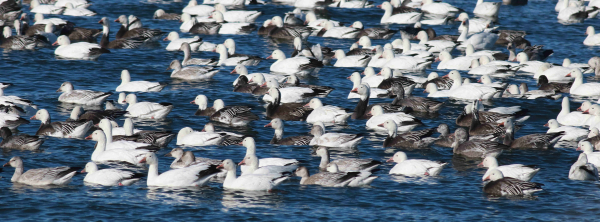
This throng of Snow Geese provides a variety of obvious photo opportunities throughout the last days before local freeze-up. As large segments of the populous reposition to feed at nearby harvested ag fields, flocks are constantly coming and going throughout much of the shortened day. Photographing geese, like many aspects of bird photography, is multi-faceted, and ever-changing; and after decades of enjoying photo sessions with Arctic-nesting geese, they still surprise me with new behaviors.
Usually, a flock this big is very wary, and they tend to limit their movements to the center of the lake, or the center of an open feeding field. Even their flights from one to another tend to be elevated beyond preferred photo range. But sometimes, just when you think it’s next to impossible to get a few of the geese to trust you, or at least fly near your position – they surprise you. Case in point: Thanksgiving Day.
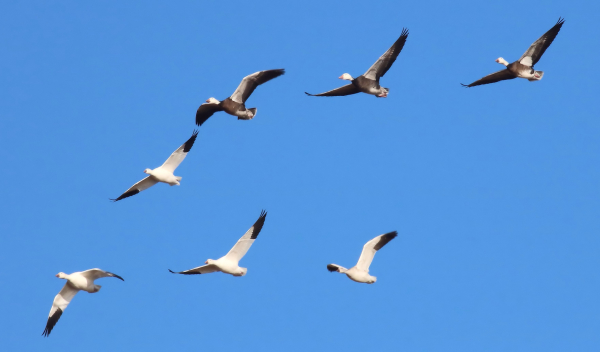
Thanksgiving Geese
A Thanksgiving outing provided a special opportunity to photograph on the edge of more than 100,000 Snow Geese! Being Thanksgiving, the quiet road that skirts the edge of the deep lake was all but deserted, and the geese responded by extending their huge flock right up to the shoreline. More than 100 geese lined the shore with hundreds more in the shallow water that extended to expansive throngs of thousands of geese that I can only imagine numbered more than a-hundred-thou. But the really crazy thing was that the geese standing on the shoreline extended up the roadside, and about 15 Snows were actually standing in the middle of the paved road – that’s an unheard of first!
I moved into position close enough to use the shoreline geese as decoys – to show others that the vehicle parked off the side of the road was no threat; and that worked quite well – for 2 hours! I didn’t mean to spend that much time with the geese, but it was a rare and fulfilling opportunity to photograph them. These Thanksgiving geese were so trusting that in time some geese swam right up to my position, just 20 feet away – white Snows and blue morphs, immatures of both color morphs, and some white-blue hybrids too. Perhaps the most exciting were the numbers of Ross’s Geese that swam near, and some even came ashore to escape the wind-driven waves. It was an exceptional experience!
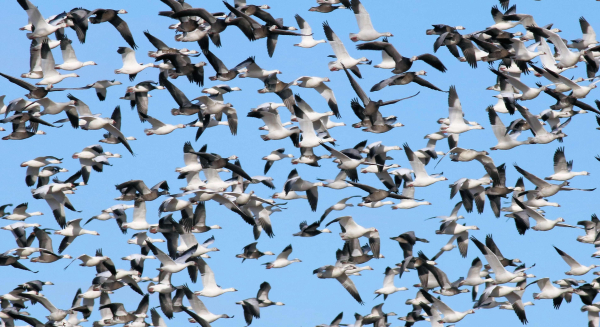
The strong west wind worked to my advantage on a couple levels. It made the huge flock on the lake position closest to the east shore of the lake. It also meant that geese wishing to land would approach the lake or lakeshore flying westward, and because the wind was strong, it tended to keep the geese at lower altitudes than usual. In addition to the assist from the wind, the sun was also adding to the quality of the photo session. Even though it was midday, about 12:30, the light was good as the sun was directly to the south with the light direction at about a 60 degree angle – nearly perfect.
Then too, every once in a while geese along an edge of the big flock would erupt from the water with a roar of wings in response to the simple appearance of a Bald Eagle. The geese rose by the thousands in a progressive wave above the lake, then swirling this way and that before returning to the water as the eagle exited the area. Overall, I counted 7 Bald Eagles in the area, a high count so far for this fall. Throughout the afternoon, I enjoyed photographing flocks and pairs and family groups of geese that flew close, often landing on the shore or waters adjacent to the shoreline. In short, the action kept me engaged and thrilled.

Pure Goose Photography
In this case, with almost unlimited opportunities to photograph varied sizes of flocks, pairs, family groups, different color morphs, and individual Snow Geese on the move, I settled in to take advantage of this holiday blessing. At times, long lines of flock after flock passed by, permitting me to pick out which flock to concentrate on, and even to single out certain birds and groups of birds to focus on within flocks.
Geese in flight are usually flapping their wings in rapid succession – up, down, up down – so I like to take 2 photographs in succession of birds I focus on. This practice provides 2 options of how the wings of a goose or group of geese are positioned. If it’s a particularly interesting group of geese, I might follow through with this ‘click-click’ practice a few times.
When picking out which birds to focus on within flocks, I must admit I tend to be attracted to the blue geese. After getting a few photos of white Snows, the blues provide a greater variety of color combinations, with normal adults, normal immatures, and a variety of hybrid color morphs that range from a blue goose with a white belly, to a white goose with some blue-gray plumage on its back, and variations in between.
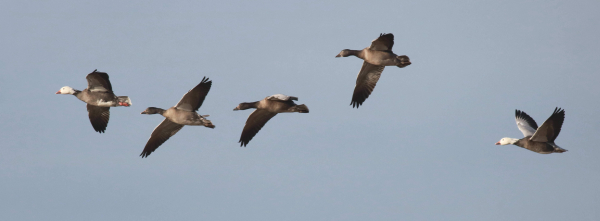
Then it becomes a matter of trying to document some geese in varied types of flight positions. For example, I appreciated a couple opportunities to photograph trios of geese as they reversed directions by flaring into the strong wind, which propelled them like missiles in the opposite direction. That action tends to be very fast, but as you are photographing geese like this, you are charged up and alert for the next photo opportunity, ready to take advantage of a new situation as it arises.
There was also the option of photographing swimming geese, including specific birds and portions of the greater blanket of geese. One thing that is quite surprising is that the overall mass of geese looks white, but when you get a closer look at portions of the flock you see a high percentage of blue morph geese; it’s just that the blues become less obvious on the water among the stand-out white Snow Geese. When you get closer, watch for opportunities to photograph Ross’s Geese in the mix. I always enjoy seeing these smaller versions of Snow Geese, although you can bet that 99.99 percent of Ross’s Geese will be white morphs – very few blue morph Ross’s Geese have ever been documented.
Practice & Testing
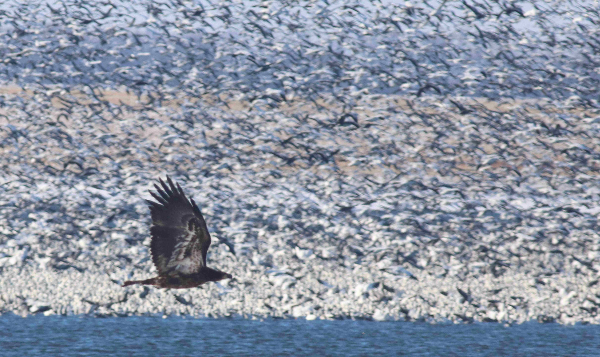
The effect on the mega-flock was predictable when a young Bald Eagle made a low patrolling flight nearby. As many as 7 Bald Eagles were present in the area, following the last concentrations of geese before freeze-up.
|
In many ways, you can take advantage of a situation like this, when timing and all the elements come together to provide so many opportunities to photograph geese before you that while you try to get some high-quality photos, it’s also a great opportunity to practice your photo methods – especially trying to anticipate the next move of birds, being patient as birds align and reposition in flight, and picking just the right moments to take your preferred photos. You can even do a little photo research, trying different aperture settings and shutter speeds, or improving how you use your autofocus, zeroing in on moving geese and trying to increase your accuracy in the process.
Eventually, the sunlight shifted to the southwest, which made my decision to end this memorable Thanksgiving photo session easier. But as I started my vehicle, another Bald Eagle flew into view and the geese reacted by flushing in huge waves that roared as thousands of wings beat in unison. I waited a few more minutes and enjoyed the action as multitudes of geese returned to the water.
Although the field photography was a wrap, there was still plenty of fun ahead – reviewing the hundreds of photographs taken during this mega-photo extravaganza. Then, eventually editing selected photos with thoughtful cropping to ensure the best framing of geese contained in the prime images. I share a few of those photos here with you, with the hope of providing some examples, information, and a little inspiration to seek out a big concentration of waterfowl in motion soon. It’s one of the great rites of fall birding that charges and recharges me. Enjoy your photo phun!
Article and photographs by Paul Konrad
Share your bird photos and birding experiences at editorstbw2@gmail.com